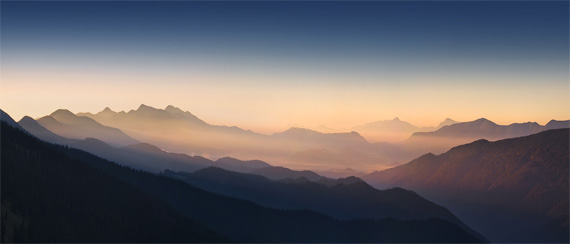by Stefan Hofer at PictureCorrect
 “Head-On” captured by Mark Broughton
“Head-On” captured by Mark Broughton
There are various phases of sunrise and sunset, however each phase repeats itself twice a day – once during sunrise and once again at sunset. All phases during sunrise are the same for sunset phases – the only difference is chronological order i.e. when each phase begins and ends. Therefore, sunrise and sunset are exactly the same, except that sunset reverses the order of phases seen at sunrise.
Twilight phases at Sunrise:
- Astronomical twilight
- Nautical twilight
- Civil twilight
- Sunrise
The phases of twilight at sunset are the same just in the opposite order. Let’s begin with sunrise and discuss each phase separately.
The length of twilight before sunrise and after sunset is heavily influenced by the latitude of the observer; therefore I will not discuss the length of each twilight phase since it is highly variable. The first phase of morning twilight is known as astronomical twilight. This period of twilight occurs when the center of the sun is between 12° and 18° degrees below the horizon and slowly increases before day time officially begins.
Most casual observers would consider the entire sky already fully dark even when astronomical twilight is just ending in the morning. Atmospheric colors consist of deep dark blue toward the horizon, and completely black when facing west. Astronomical twilight really brings cityscape photos to life. The deep blue mixed with warm artificial lights from city buildings, streets, and cars produce nice contrasts. Arguably, this is the best time to photograph cityscapes, but this clearly depends what you’re attempting to capture. Images during all twilight phases and during sunrise require a tripod. The photo will be blurry, regardless if your lens has vibration reduction or image stabilization.
Nautical twilight is when the center of the sun is between 6° and 12° below the horizon. The primary color cast across the atmosphere is usually a deep blue hue with noticeable orange and yellow tones at the horizon due to the rising sun. Light will begin appearing quickly throughout this phase, and the blue sky will get begin to get brighter and paler. Details will become easier to distinguish but will lack most edge definition. Again, cityscape photographs are nicely produced during this phase. Most landscape photographs will be uninteresting during this phase because there is not enough available light. Silhouettes begin to look interesting, and get better in the next twilight phase.

"Winter Solstice in Reykjavik" captured by Ævar Guðmundsson
Civil twilight is the brightest phase of twilight and begins when the geometric center of the sun is 6° below the horizon and ends at 0° sunrise/sunset. The horizon is clearly visible and shadows are easily discernible. Objects are clearly defined and no additional light is needed in most cases. The light cast during this phase can be anywhere from warm golden tones to cool pink tones. During civil twilight, the colors of the sky are going to change quickly. Colors of pale yellow, neon red, and bright orange will dominate the sky. If clouds are present they begin changing colors, first from soft pink then to deep ruby-red. When looking westward you can see the twilight wedge, which is a mixture of Earth’s shadow and scattered light. The pink and blue hues of the twilight wedge are separated by multiple layers. Most landscape photos begin coming to life as available light increases and details become obvious.
When the sun finally rises, deep ruby-red and dark pink colors splash all over the terrain. Shadows come alive and retain purple and blue hues due to scattered light. The contrasts of red and blue are at a pinnacle, and will arguably provide for the best landscape pictures. The mixture of colors and shadows helps distinguish form, shape, and texture, and these compositional elements should be utilized. The color of light is quickly changing from red to yellow, and you must react very fast if you decide to change composition or frame. As the sun continues to rise in the sky, colors shift from yellow to white. This is why the first hour of sunrise and sunset is called the “golden hour“, because red light shifts to gold. After the first hour of sunrise the color of light begins turning whiter and is not conducive to most landscape photography. The only circumstances that could create gorgeous photos in midday are during storms when the sun breaks through high clouds illuminating spots of land. Otherwise, forget about taking good landscape pictures – they will not be compelling.

Photo captured by Denis Krivoy
The best time of day to create evocative landscape imagery is during twilight and sunrise/sunset. There are rare exceptions when these “rules” do not apply, which is why if you are seriously considering landscape photography you must be out in the wilderness during these hours. Yes you will miss breakfast and dinner, yes it will be hard waking up very early in the morning, and yes you will be frustrated many times when the photo opportunities are just not there because it’s too cloudy, or no clouds, etc. But who ever said photography was easy? This stuff is not meant for the meek. As with anything in life you have to really want it. You have to be passionate about taking away a beautiful photo, even though it took many visits to the same spot to get your photo. This stuff can be grueling at times, but for me, the rewards far outweigh the repeated disappointments. I hope this article has helped those seeking to become landscape photographers.











